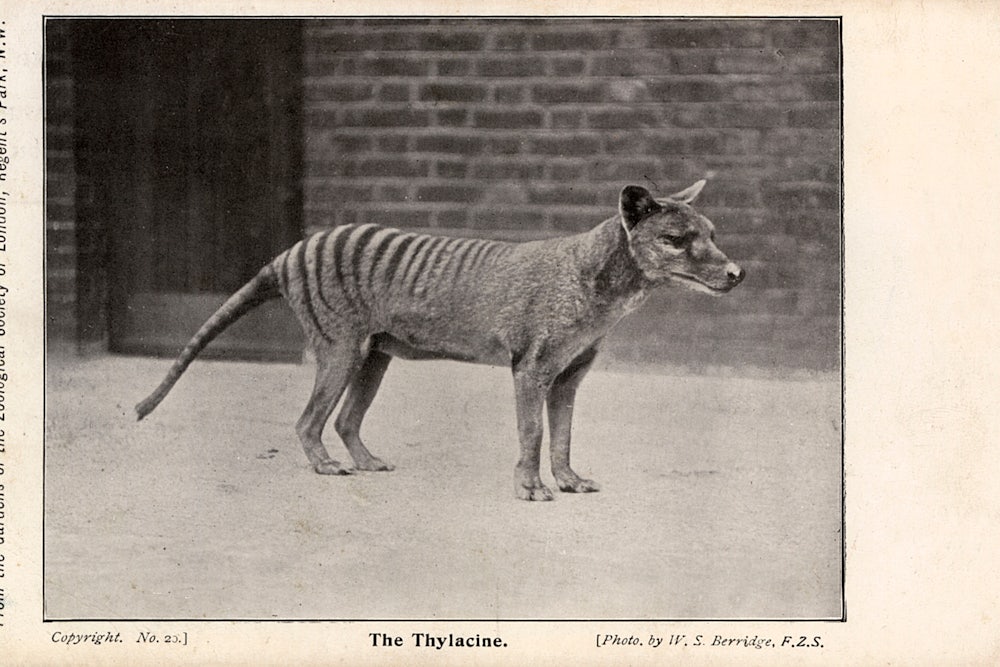The last Tasmanian tiger, an individual named Benjamin, died a lonely death of exposure in an empty, cold cage in a zoo in Hobart, Tasmania, in 1936. The coyote-size animal—the last marsupial apex predator on earth—had disappeared from the Australian mainland some two thousand years earlier and was then hunted off Tasmania in the nineteenth century by the European convicts who colonized that island. Now a group of adventurist scientists and rich tech bros want to bring it back through genetic engineering.
The ecological argument is that Tasmania’s environment has suffered from a lack of apex predators, a problem in many places. If you find yourself picking too many ticks out of your scalp because there are too many deer in your suburb, or noticing that your garden is besieged by rabbits, you are probably living in such a place. But you probably had not considered such an exotic remedy. After all, there would be downsides to bringing the saber-toothed tiger back to Miami.
There’s something irresistibly sci-fi about the idea of bringing back an animal that has been extinct for nearly a century. The same company working on this project is also trying to revive the woolly mammoth, which has been extinct for much longer than the Tasmanian tiger (about 10,000 years). But resurrecting long-extinct species is daft, a waste of resources, and should be resisted.
Resurrection efforts are expensive, with outcomes unclear. The genetic work is complex, and the animals—if any live animals do result—will likely be some kind of hybrid, not the original mammoth or tiger. They may be no better suited to our world than poor Benjamin was to his cage. None of these ecosystems are the same as they were when the mammoth lumbered over the tundra, and may not be at all prepared for such a significant intruder. Many scientists have warned about the potential for introducing or spreading zoonotic diseases, given that extinct species may have been particularly vulnerable to certain illnesses. Especially after the last couple years, that alone seems like reason enough to think again.
The company behind this, Colossal (tagline: “The science of genetics. The business of discovery”) has attracted investors like Peter Thiel, a billionaire libertarian Trumper, and an array of venture capitalists. Considering the dire effect people of this class have had on our world, it’s unlikely that any of their ideas are going to save it.
Bringing back animals from extinction has one thing going for it, as one scientist put it: “awesomeness.” How cool would it be to save something once thought irretrievable, like the dodo bird?
But you know what’s even more awesome? The world we are losing right now.
Animals currently endangered range from the absurdly cute desert kit fox, whose ears are larger than its head, to such charismatic megafauna as the manatee or the gray wolf to homely fellows like the Mexican long-nosed bat.
By some estimates, thousands of species go extinct every year. A recent United Nations report found that one million animal and plant species were in danger of extinction, more than at any other time in human history. The disappearance of each of these could have complex effects on present-day ecosystems, and saving them is a better use of resources than bringing back the Tasmanian tiger.
Even our own flawed government knows how to do this and is constantly saving species from the brink of extinction. Recent successes have included the grizzly bear, the black-footed ferret, the whooping crane, and in a bit of symbolism that deserves far more heavy-handed propaganda, the bald eagle, our national bird. While genetic engineering can play a role in some of this work, what’s much more salient is protecting habitats and crafting the appropriate regulations on human activities that affect these species.
Saving endangered animals and plants from going extinct requires extensive government intervention and spending, just the sort of thing that right-wing tech billionaires like Peter Thiel dedicatedly oppose. This kind of work doesn’t get as much attention.
Luckily, and perhaps surprisingly, however, wildlife conservation policy enjoys bipartisan support. As Vox recently reported, Congress is about to pass the biggest wildlife protection bill in 50 years (unrelated to the climate policy contained in the Inflation Reduction Act, which clearly will also affect wildlife). The Recovering America’s Wildlife Act, or RAWA, has passed the House and is expected to pass the Senate in September, with Republican co-sponsors in each body (including 16 in the Senate). The bill provides nearly $1.4 billion a year not just to help those creatures already on the endangered species list but to prevent vulnerable animals like New York’s saltmarsh sparrow from getting on that list in the first place. This is smart policy—so smart that it may seem amazing that our dysfunctional system could produce it with so little fanfare. The hypothetical Tasmanian tiger revival has attracted more national media attention, and so has the woolly mammoth, but RAWA is significantly more likely to help keep our world awesome.
Venture capitalists’ attraction to the Tasmanian tiger project feels not so much altruistic as childish; it’s a classic misapplication of the power that money brings, attempting to do something that seems impossible rather than a possible thing that improves the world. In Milton’s epic poem Paradise Lost, the character of Satan promises humans that “ye shall be as Gods … what are Gods that Man may not become as they?” Peter Thiel has also funded research on human immortality, another project that would have delighted Milton’s Satan. But rather than rejecting all limits and boundaries in this infantile manner, what nature actually needs is for humans to set more limits and boundaries on ourselves. That’s why RAWA is so astonishing and so welcome—and why tech billionaires and venture capitalists should be kept far away from everything we love.










